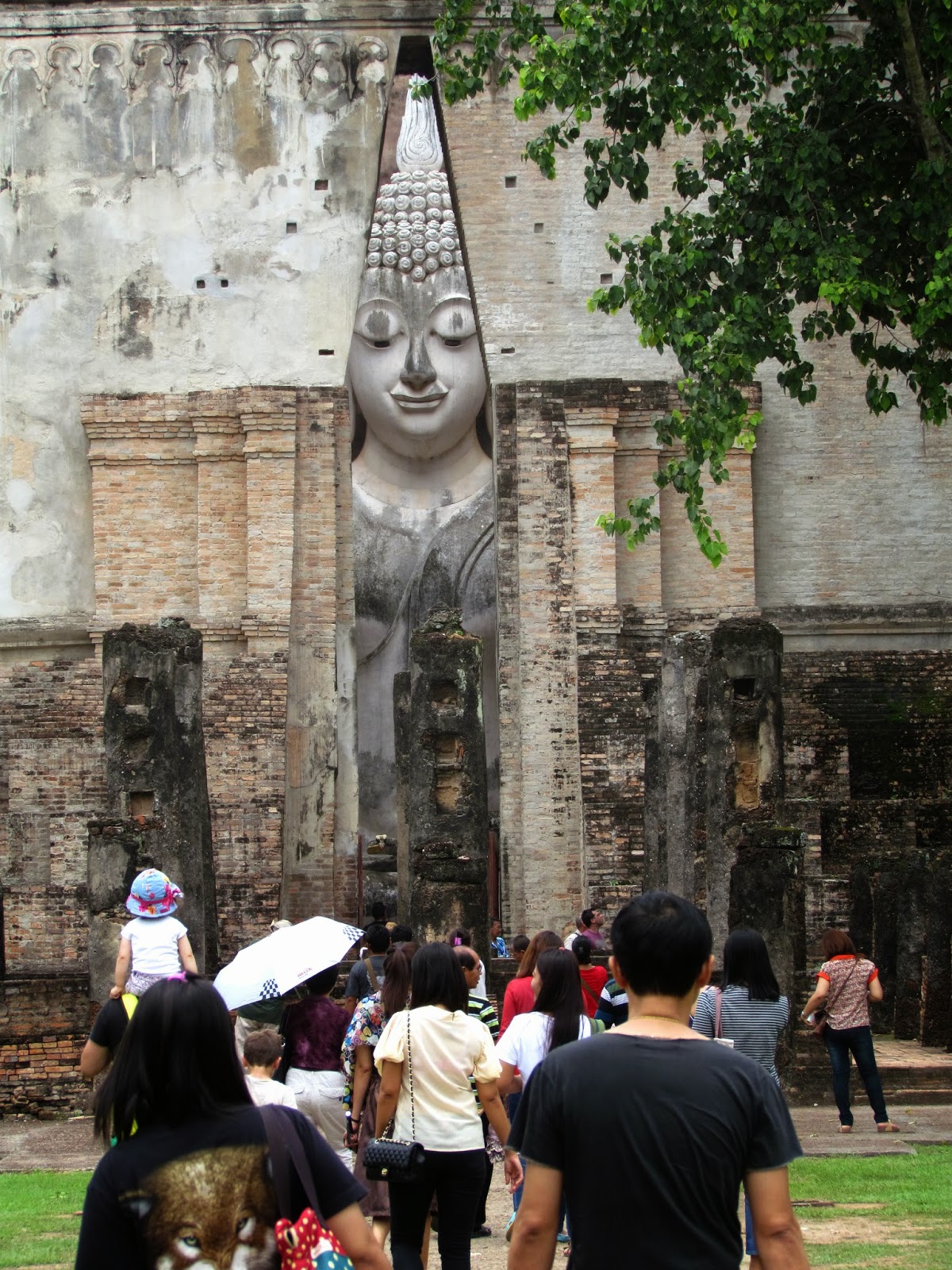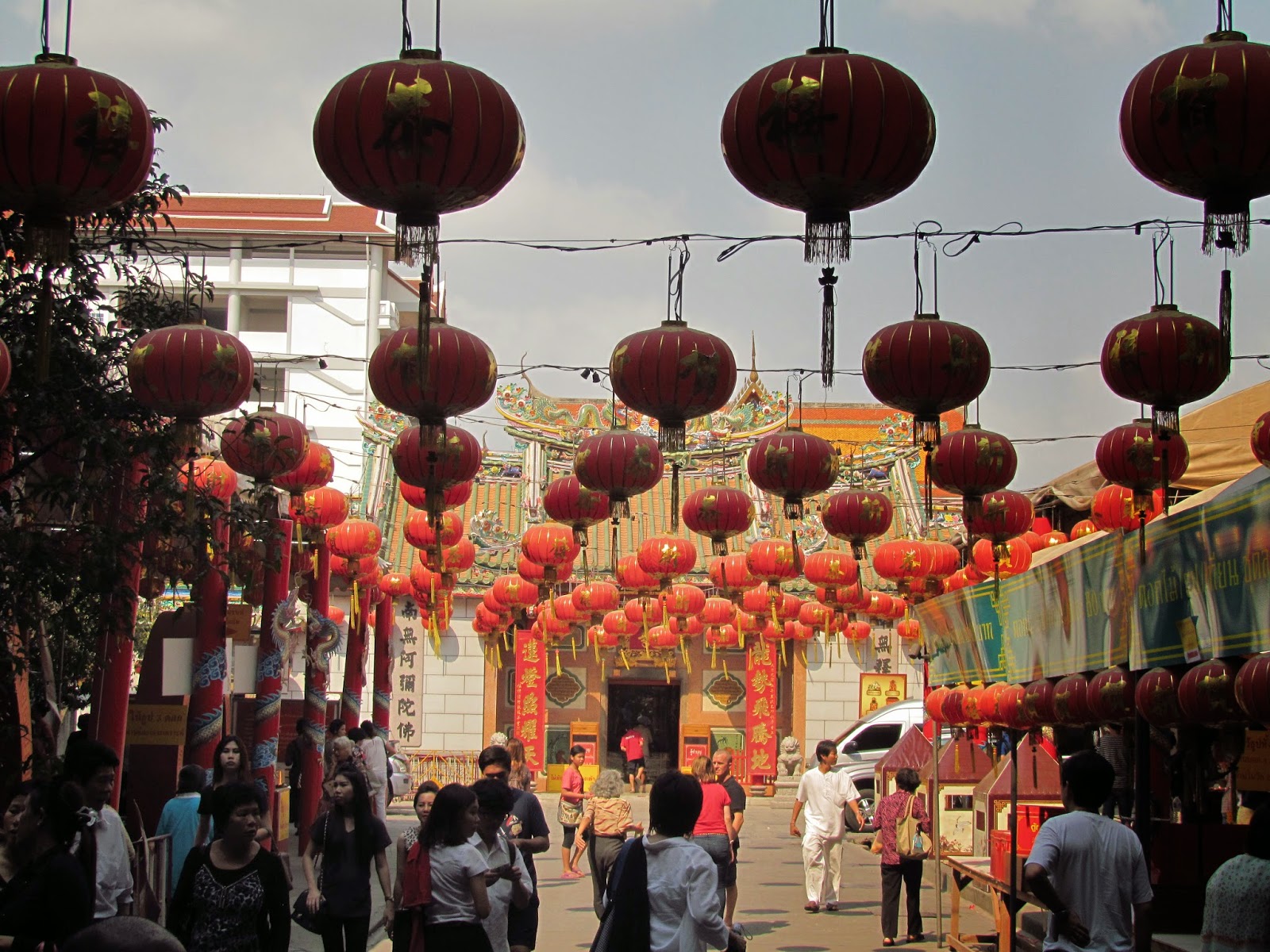 |
| Carved design of Si Satchanalai Historical Park |
To get to Si Satchanalai, we had to travel 60km and there is a few ways to do the ride. No way were we walking or biking there and we didn't fancy taking a public bus - although this is a very easy option -, we just wanted to do it at our own pace . So we had one other option; renting a motorcycle and driving all the way there and back. For 300 bahts we got a brand new scooter at the Chopper Bar with a full tank. Upon return you have to give it back with a full tank, just in case you are wondering, which is about 100 bahts.
 |
| Our great ride |
We left Suhkothai taking highway 1195 - the same one that goes to the Sukhothai Airport - and headed up north. If you are renting a bike, I would recommend you to take this highway, instead of the 101, it is easier, prettier and carries a lot less traffic. We went through rice paddies, wheat, tobacco and fruit fields in a never ending rainbow of greens. You pass Si Samrong, the airport, Sawankalok and then you'll come to the intersection with highway 1048. Here things could get a bit complicated, but there are a lot of signs (all along the way), that are very easy to follow. So we just followed the signs and after about an hour - a bit more - we were entering the Si Satchanalai Historical Park.
Salimos de Sukhothai por la carretera 1195 - la misma que va al aeropuerto - con direccion norte. Si piensan alquilar una moto, les recomiendo esta carretera en lugar de la 101, es mas facil, bonita y con mucho menos trafico. Atravesamos campos de arroz, plantaciones de trigo, tabaco y frutas en un sin fin de tonalidades de verde. Pasamos Si Samrong, el aeropuerto, Sawankalok y llegamos a la interseccion con la carretera 1048. Aqui las cosas se podrian complicar un poco, pero hay muchas senales (todo el camino) muy faciles de seguir, asi que despues de poco mas de una hora estabamos entrando al Parque Historico de Si Satchanalai.
Since you enter the park you are overwhelmed by green. There is vegetation everywhere and small slopes around, which give the place a feeling of being a lot more in harmony with nature, than any other ruin site I have seen in Thailand. Some of the ruins are still been claimed by the vegetation and some paths have even disappeared, which immediately raises your explorer excitement. The park is huge (over 2,000sq km) so you better have an attack plan for it. We decided to go for the area within the wall first, as here is the biggest concentration of sites, and save the famous Wat Phra Sri Rattana Mahathat for the end.
 |
| Stupas, chedis, shrines and temples surrounded by vegetation everywhere |
Apenas entrando al parque, ves que hay mucha vegetacion y pequenas colinas por todos lados, lo que da al sitio una enorme armonia con la naturaleza, mas que caualquier otras ruinas que haya visto en Tailandia. Algunas de las ruinas han sido cubiertas por la vegetacion y algunos senderos ya desaparecieron, lo cual eleva tu nivel de explorador. El parque es grande (mas de 2,000km cuadrados) y es mejor tener un plan de recorrido. Decicimos ir primero por el area dentro de la muralla, ya que aqui esta la mayor concentracion de ruinas y dejar el famoso Wat Phra Sri Rattana Mahathat para el final.
 |
| Wat Chedi Chet Thadeo |
 |
| Stupas holding the Royal Ashes |
 |
| Vihara columns and main shrine at Wat Suan Kaeo Utthayan Yai |
 |
| Sri Lankan chedi at Wat Nang Phaya |
Un poco mas al este, esta el templo de Wat Suan Kaeo Utthayan Yai. Tal vez no es tan majestuoso como debe haber sido hace 700 anos, pero con un poco de imaginacion, uno puede ver como debe haber sido con su vihara (termino en Sanscrito y Pali que significa; un lugar retirado para caminar) sostenido por 10 enormes columnas de laterita. Un poco mas al este, llegamos a las increibles ruinas del templo de Wat Nang Phaya, con su espectacular chedi (estilo de Sri Lanka) y sus paredes exteriores donde aun se pueden ver restos de grabados en alto relieve al estilo del periodo Ayutthaya.
 |
| Wat Nang Phaya |
 Across the road, we find three opposite temples, Wat Suan Keao Utthayan Noi, Lak Muangand Wat Udom Pa Sak, which in contrast to the three we just walked through, have been greatly covered by vegetation and have therefore a much more mystical feel about them. These were all minor temples or shrines, with Buddha images, maybe not as impressive as their neighbors across the road, as not much of them is still standing, but worth visiting and walking between them and through the vegetation.
Across the road, we find three opposite temples, Wat Suan Keao Utthayan Noi, Lak Muangand Wat Udom Pa Sak, which in contrast to the three we just walked through, have been greatly covered by vegetation and have therefore a much more mystical feel about them. These were all minor temples or shrines, with Buddha images, maybe not as impressive as their neighbors across the road, as not much of them is still standing, but worth visiting and walking between them and through the vegetation.  |
| Wuat Suan Keao Utthayan Noi |
After these first set of temples, we decided to head towards the southwest corner of the citadel and the mountain temples. First we went to Wat Khao Suwankhiri, built on top of the Suwankhiri hill, where this temple holds an outstanding chedi, which provides an amazing view of the surrounding jungle and then, after following a path through the jungle, we came up to Wat Khao Phanom Phloeng. Due to it's privileged location and view, one of the most famous temples in the area. It has a very long set of steps that take you all the way to the top, which represents "getting closer to heaven" and therefore bringing your offerings and prayers, closer to the gods.
Despues de visitar este primer grupo de templos fuimos hacia la esquina sud-oeste de la ciudad y los templos en las montanas. Primero visitamos Wat Khao Suwankhiri, construido sobre el monte Suwankhiri, el cual tiene un impresionante chedi desde donde se tiene una gran vista de la jungla que nos rodea. Luego siguiendo una trocha a traves de la selva llegamos a Wat Khao Phanom Phloeng. Gracias a su privilegiada ubicacion y vista, uno de los mas famosos del area. Tiene unas largas escaleras al lado principal, que te llevan hasta la cima, "acercandote al cielo" y por esto, trayendo tus ofrendas y rezos mas cerca a los dioses.
 |
| Sukhothai Noodles |
Ya habia pasado la hora de almuerzo cuando decidimos ir a un restaurante local a probar una delicia local antes de ir a los dos ultimos templos de nuestra lista. Por menos de 300 bahts, probamos los Fideos Sukhothai. Hechos con fideos de arroz cocinados en en una salsa dulce de limon con chauchas verdes, servidas con mani, pollo asado y carne y piel de cerdo fritas. Increiblemente deliciosos.
 |
| Wat Chang Lom |
 |
| Elephant statues at Wat Chang Lom |
 |
| Wat Phra Sri Rattana Mahathat |
 |
| Bayon style Buddha image decorating the main entrance |
The next temple we went to, was maybe the most spectacular of them all. Wat Phra Sri
Rattana Mahathat. It's located on the eastern corner of the Si Satchanalai park, so we had to jump back on the bike and cover the 6km between the old city and the temple. From the moment you walk into it you are amazed. In the entrance gate, you are welcomed by a decorative stucco in the best Bayon (in Angkor, Cambodia) style, and this together with some archaeological evidence found here, under two prior buildings, states that this temple was built before the Sukhothai Kingdom and talks about the already existing relations between the Khmer and Siam Kingdoms.
 |
| Partial view from the stupa |
 |
| Main chedi at Wat Mahathat |
Al escalar el gran chedi principal, la vista es espectacular, el diseno del templo mezclado con los campos, y el rio Yom hacen ver porque escogieron este lugar para el templo. Ademas hay un chedi en estilo Mon (inusual en estas partes) y una imagen de Buda en posicion Maraviajya (victoria sobre Mara) frente al templo principal que redondean la importancia religiosa y popular del templo.
We walked through all the corridors of this temple, it's many chedis, shrines and images trying to pay attention to all the little details we hadn't seen before, different materials, walls, colours, this was definitely, the highlight of the day. But now it was starting to get late and we still had to drive all the way back to Sukhothai and enjoy a few, very well deserved, beers.

Caminamos a travez de los corredores, sus chedis, altares e imagenes, tratande de prestar atencion a los mas pequenos detalles, diferentes materiales, paredes, colores, estilos y las horas que pasamos ahi nos quedaron cortas. Cuando nos dimos cuenta, ya estaba empezando a atardecer y aun habia que regresar hasta Sukhothai, a disfrutar de varias, bien merecidas cervezas heladitas.
Tomorrow, we will be taking the bus back to Bangkok, there are a couple of companies which have vip service, back to Mo Chit bus station for about 400 bahts. It takes around 7 hours (meaning 10!), but it will definitely be enough time for us to absorb all we've seen this weekend and to start planning where our next adventure should take us.
 |
| Mon style chedi |
Manana vamos a tomar el bus de regreso a Bangkok, hay un par de companias que tienen servicio vip hasta la estacion de Mo Chit por 400 bahts y sabiendo el trafico que nos espera entrando a Bangkok, vip es un gran lujo. Se supone que nos demoramos 7 horas, osea 10, pero esto va a ser suficiente tiempo para absorber todo lo que hemos visto este fin de semana y para empezar a planear donde nos va a llevar nuestra siguiente aventura.
Some information about transportation used and places visited.
Si Satchanalai Park, http://www.thaiwebsites.com/sisatchanalai.asp
Chopper Bar, find it in Facebook as Chopper Bar





































